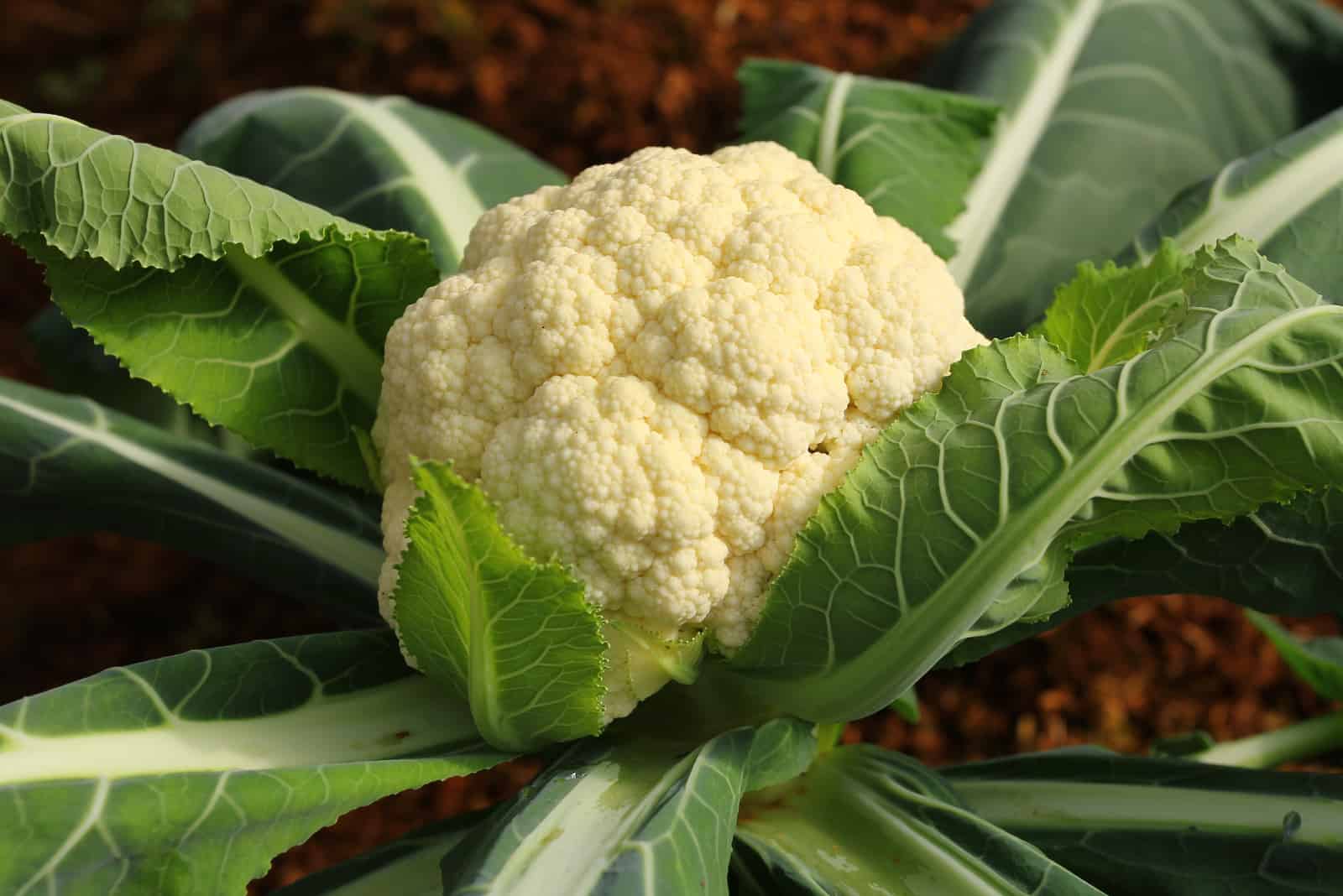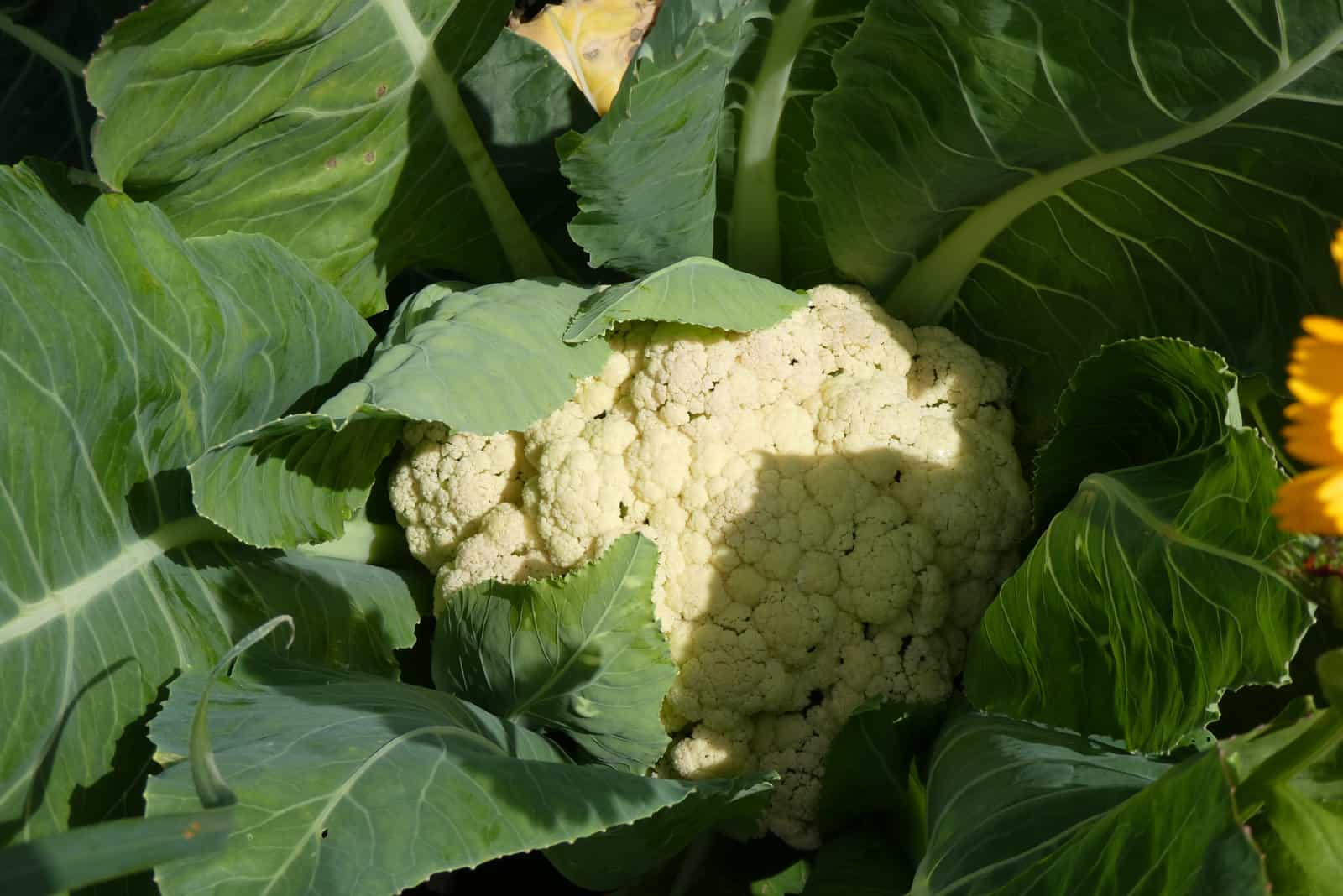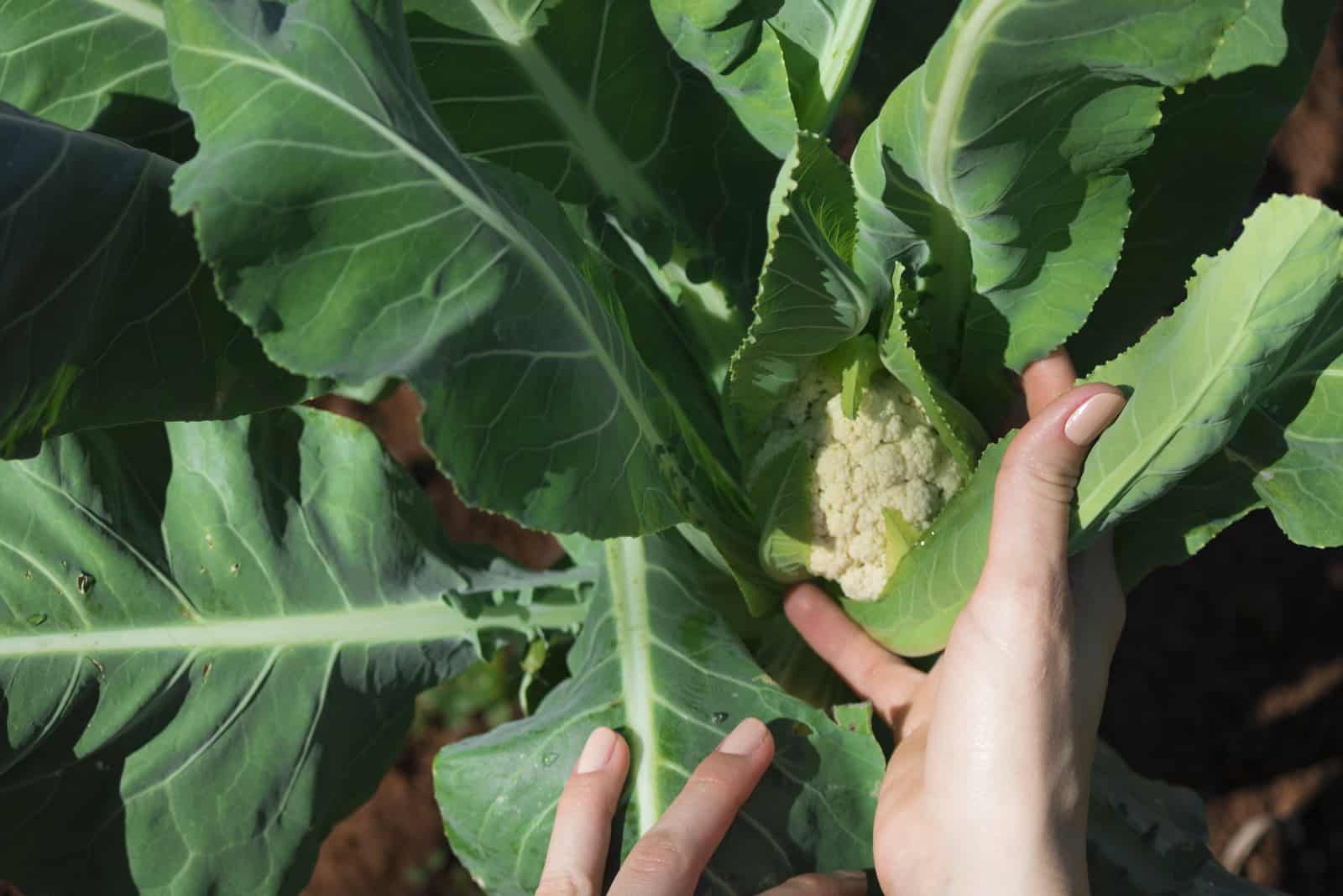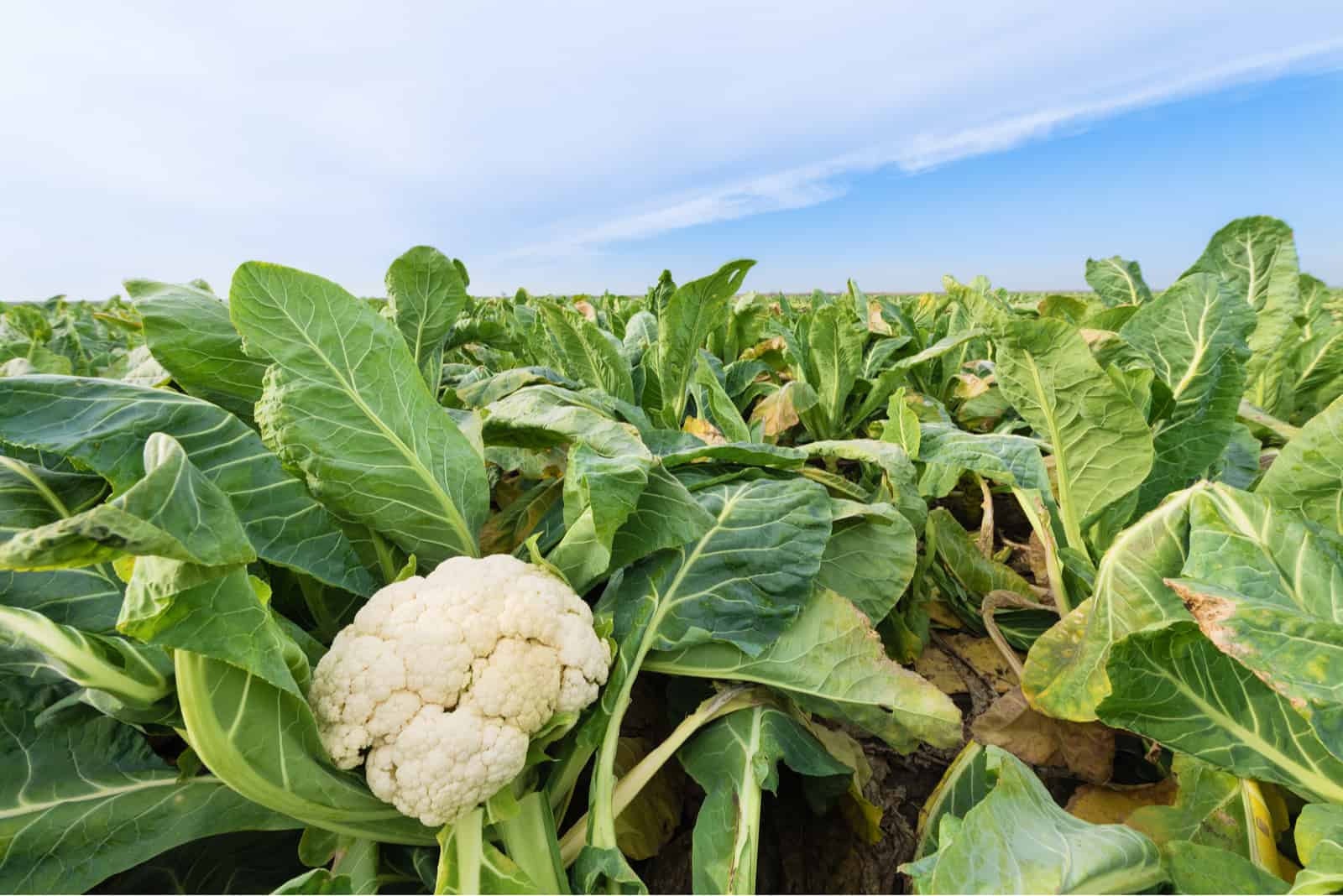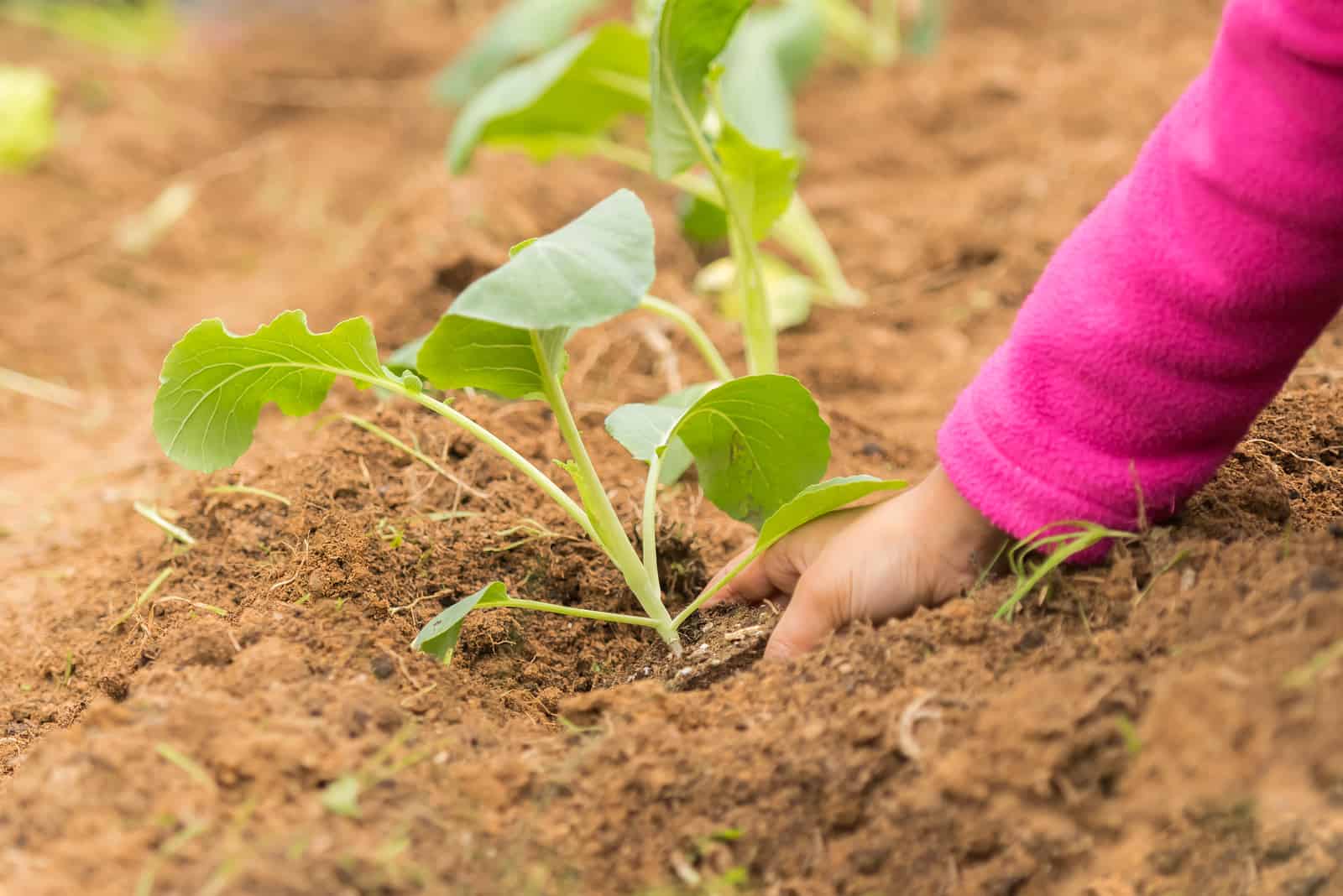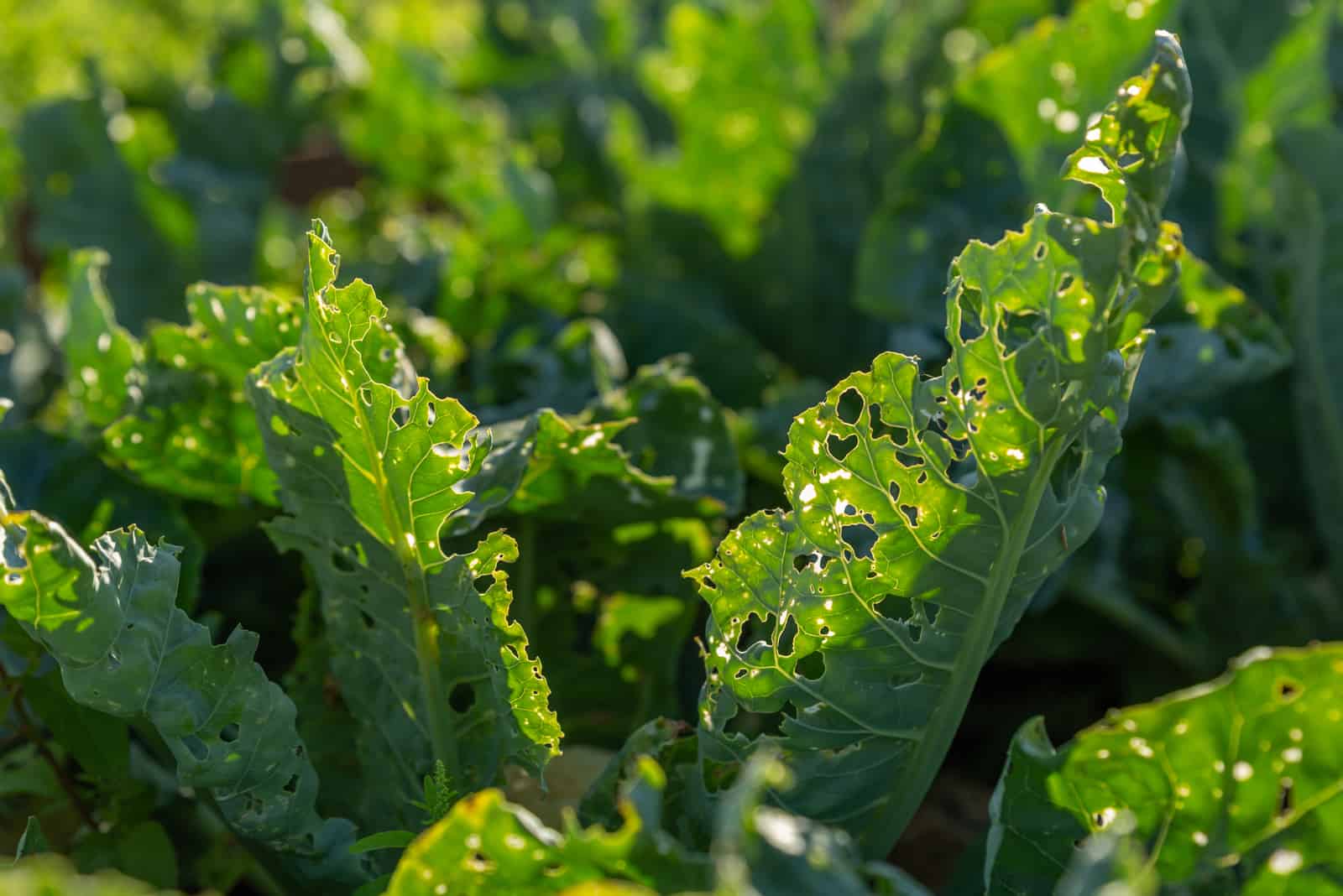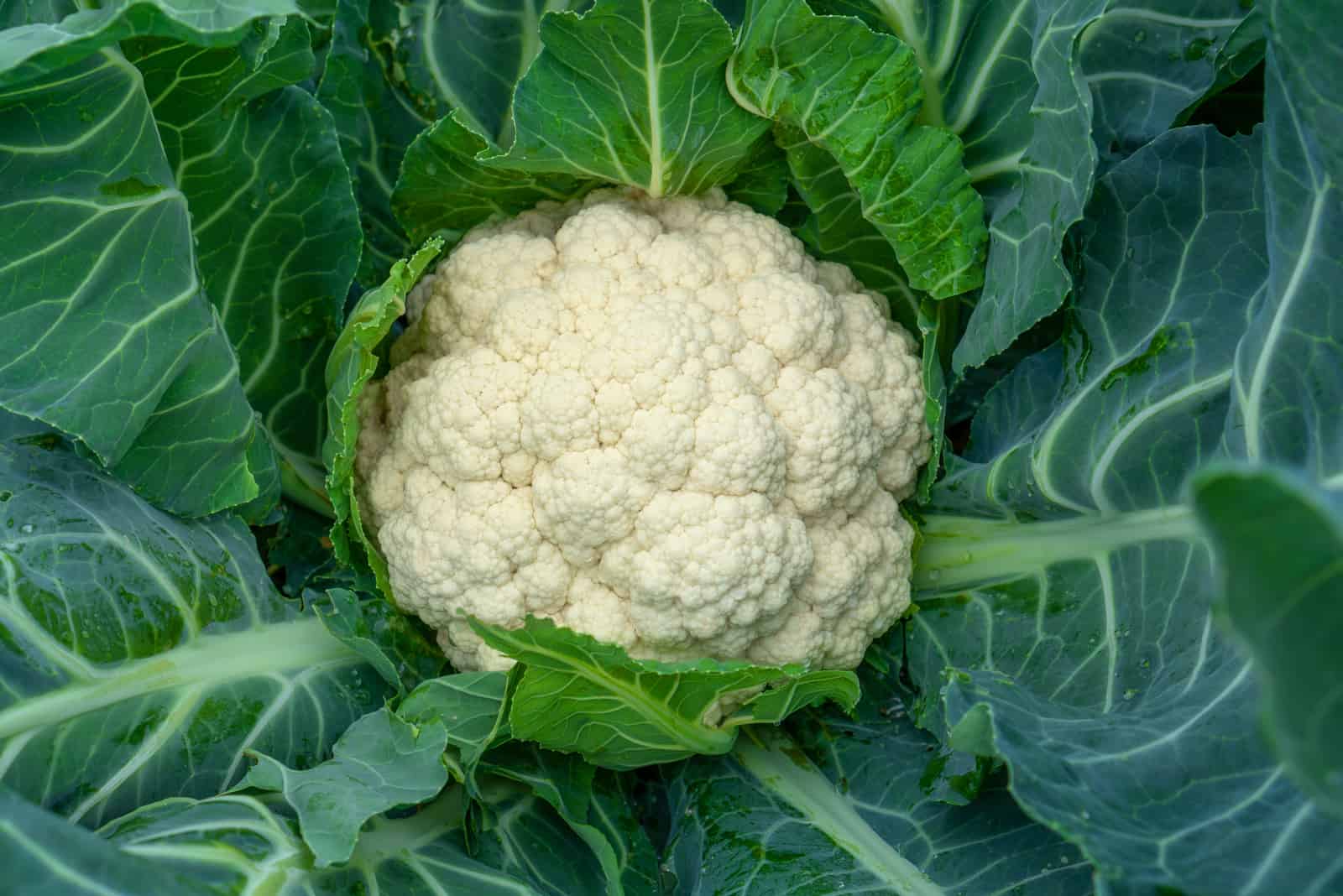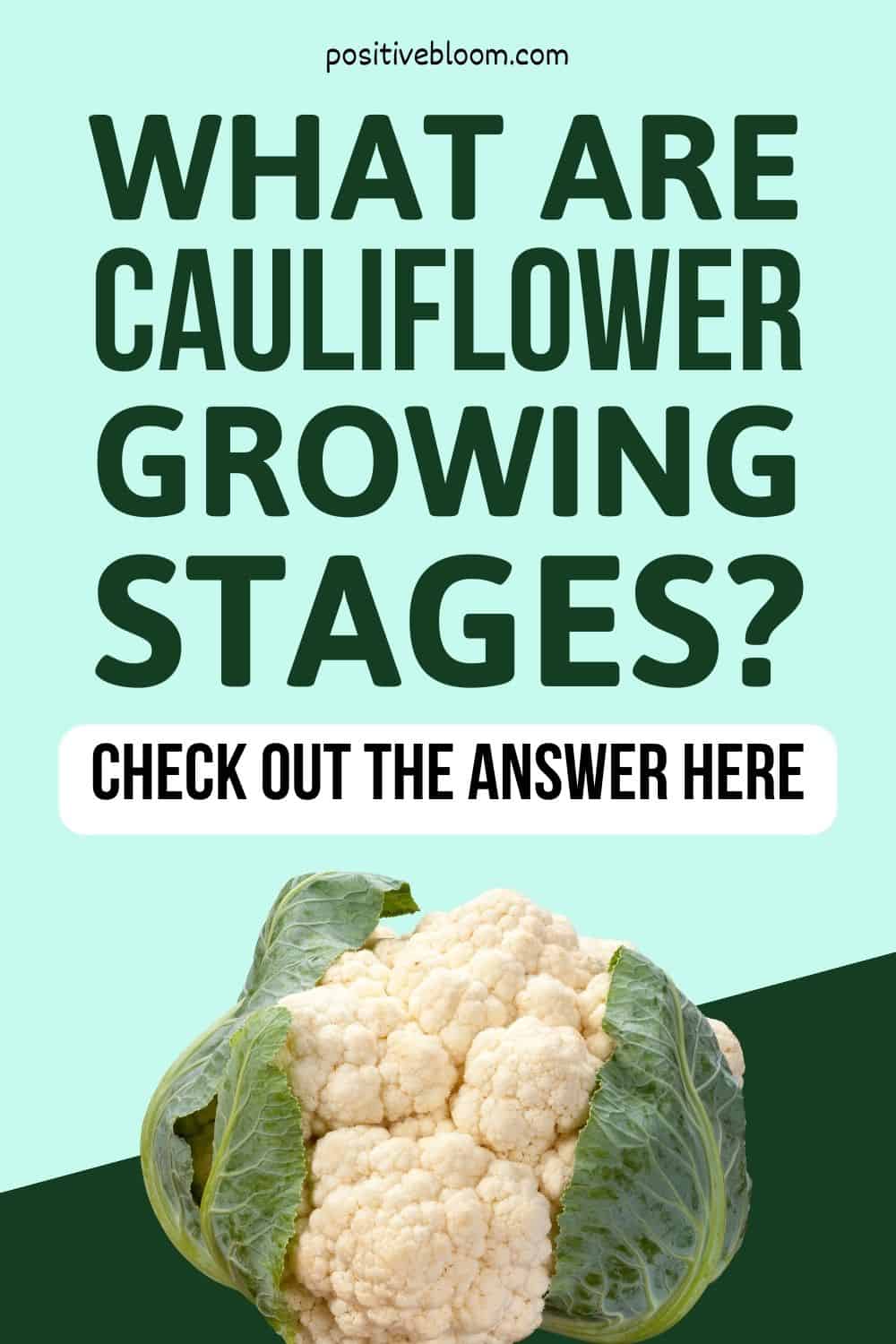Yum! Yum! Yum!
Today we are going to talk about my favorite vegetable – Cauliflower!
Cauliflower is super beneficial to our health, having high amounts of vitamin B and fibers in its leaves, stems and head, which are all edible. Not only does the Cauliflower possess antioxidants that can help with cancer prevention, but it also has fibers that help with digestion and weight loss (no wonder all fitness influencers constantly recommend it).
Cauliflower is a part of a huge Brassicaceae family, together with kale, cabbage, broccoli, kohlrabi, brussel sprouts… They are all related and together they make a healthy vegetable family, packed with nutrients and fibers.
Cauliflower is also known as Cole Crop, and its botanical name is Brassica oleracea botrytis. Cauliflower plant grows to about 1.5 feet, so it won’t take up a lot of space in your garden. It has a distinctive, white cauliflower head; though the color of the heads can be orange, purple, brown and green – it depends on the Cauliflower variety.
We are going to cover the Cauliflower growing stages, as well as its care, plantation and its common problems.
So, let’s dive in!
What Are Cauliflower Growing Stages?
Cauliflower is a biennial plant that takes two growing seasons to reach full maturity – though they can be harvested annually in regions with colder winters.
After you sow the Cauliflower seeds, your plant will go through five different stages in its growth cycle – first being germination, followed by seedlings, leaves growth, flowering and production of seeds.
Bear in mind that nasturtium is a great companion to cauliflower, thus you should consider planting them together.
First Stage: Germination
After you have successfully planted your Cauliflower seeds – whether directly in your garden, or if you started the plant indoors – you have to keep its soil moist enough in order for germination to occur.
Germination will take about 8 to 10 days, and then you will soon be able to see new seedling leaves (also known as cotyledon) that will transfer into the true leaves of your new plant.
If you don’t notice any growth two weeks after planting, something might be off and you should try and plant the seeds again.
Second Stage: Cauliflower Seedling
If you have started your plants indoors, after it has reached a height about two inches, it is time for its transplantation into your vegetable garden.
You will have to deal with the plants carefully, as they are extremely sensitive at this stage and can be damaged easily.
Plant seedlings in a way where they are separated by at least 12 inches from one another, they are usually grown in rows. Pay attention to the location as well, because your plants will benefit from partial shade at this stage.
You can also set up a beer trap (this won’t trap real beer unfortunately!), and maybe some snail pellets to protect your young plant from snails and slugs.
Third Stage: Leaves Growth
Your plant is now developing as the time goes by – soon, you will start noticing that the leaves have started expanding and forming much more complex structures.
Your Cauliflower plant will require much more frequent watering now, particularly if it is not raining that often in your area. To retain moist soil and prevent weeds from growing, you can add mulch around the base of your plant.
If not, make sure to remove weeds because they can disrupt further development of the plant.
In this Cauliflower growing stage, you can start adding fertilizers; I would recommend that you use liquid fertilizer once a week, or every two weeks. Avoid using fertilizers that contain nitrogen, as they can prevent the head from growing.
Fourth Stage: Cauliflower Head Growth
Immediately after the leaves have developed, you can expect to see the little head (also called curd) appearing in the center of the leaves.
Now, this small Cauliflower head is still very sensitive, and you will have to protect it from full sun and hard winds.
The best way to do that is by blanching – this is a process where you gather the outer leaves and tie them with rubber bands or twine to protect the developing head.
Some varieties of Cauliflower are able to self-blanch, but we’ll get into that more later on.
Fifth Stage: Flowering
This is the last Cauliflower growing stage. You don’t have to wait for flowering to occur in order to harvest Cauliflower – you can do it after the maturing head has a white color and compact form, which is usually between 80 to 130 days after planting.
Flowering usually occurs when the plants have been planted in your garden for quite some time – when you notice flowers on your Cauliflower plant, it is an indicator that your plant has reached full maturity and is now ready to produce baby seeds!
Flowers will attract bees and insects that will pollinate your plant, which leads to the production of seeds. You can cut the flowers once they’ve turned brown, dry them, pick the seeds and save them for the next growing season.
More About Cauliflower
Cauliflower is a man-made type of cruciferous vegetable, because the flowers grow four petals which look like a Greek cross.
It grows a single white head without side shoots that looks like a cloud surrounded by large, green leaves. But, have you ever wondered why the Cauliflower head is actually white?
It is because of blanching!
When blanching occurs, the large leaves protect the head from sun, thus, they are not able to form chlorophyll, which is why they remain white instead of green.
Veggie science is cool!
Cauliflower flavor has a kind of sweet taste, with a bitter undertone. I personally love separating the little white trees from the Cauliflower head and eating them raw, it’s way more fun than chopping them into pieces.
We are all familiar with the White Cauliflower, but there are numerous varieties of Cauliflower that produce different head colors and shapes… just imagine, there is a green cauliflower with spikes all over it! Some of the cultivars include the Snowball and the Snow Crown Cauliflower, the Purple of Sicily Cauliflower, the Romanesco or Broccoflower, the White Corona (that name didn’t age well), the Flame star hybrid and so on.
How To Plant Cauliflower
I see that you are interested in planting Cauliflower in your own garden – don’t worry, it’s easy peasy!
You can plant Cauliflower in early spring, or during fall – it really depends on the type of Cauliflower you wish to grow.
Spring-planted Cauliflower should be planted in early April and harvested during summer, while fall crops are usually planted near the end of July for a fall harvest.
You will have to use row covers in both cases, to protect your new plant from cold in the spring, and from hot temperatures during summer.
You can either start your plant indoors, or plant it directly in the ground.
Just follow the instructions below and you will be able to eat your very own Cauliflower.
Planting Spring Cauliflower:
1. Prepare a soilless seedling mix, in which you will sow your Cauliflower seeds about half an inch deep.
2. Germination should occur in the first two weeks. After you notice seedlings, provide them with grow lights to aid their development.
3. When you see the new true leaf, you should apply a half-strength fertilizer once a week; or twice when more true leaves start appearing.
4. If the plant has grown at least five true leaves, you should start hardening your plant by reducing water, because it is time for transplanting!
5. Choose a location in your garden that will get a few hours of sunlight throughout the day, and is not windy – wind can thorn off the covers and completely destroy your plant.
6. Dig holes that are at least 18 inches apart from each other and plant your Cauliflower seedlings.
7. Water them in, or apply a liquid starter solution that contains high amounts of phosphorus, and less nitrogen.
8. Put row covers on.
Planting Fall Cauliflower:
1. In this case, you will directly plant your Cauliflower in the ground. The best time for planting fall crops would be mid or late July.
2. Sow the seeds about a half inch deep and separate them 18 inches from each other.
3. Water regularly and thin the seedlings.
4. Use row covers.
Cauliflower Companion Planting
If you have decided to plant Cauliflower in your vegetable garden, you should know that some plants might benefit from their neighboring plant!
Companion planting is commonly practiced in gardening, and it is a way that plants help each other a bit by attracting good insects, repelling bad ones, or by having different nutrient requirements.
For instance, Cauliflowers and beans are the perfect combination in planting because both plants attract good insects and repel the bad ones; however, a combination of celery and Cauliflower is tricky – as although the celery can attract beneficial insects, it also requires a lot of water, just like our Cauliflower.
The plants that you can combine with your Cauliflowers are: beans, onions, spinach, brussel sprouts, broccoli, radish, beets, corn and cucumber.
You should avoid planting Cauliflower next to peas, as well as strawberries (both plants would be eaten by slugs).
Though some plants might be a good companion to your Cauliflower, it might not mix well with other companion plants – for example, onions and beans don’t mix at all!
How To Grow Cauliflower
Now that we have covered the planting and the Cauliflower growing stages, it is time to see how we can take care of our precious vegetables. Check out what your plant needs in order to grow healthily and happily!
Soil Requirements
Cauliflower thrives in well-draining and loose soil that is rich in nutrients. The soil pH should be between 6 and 7, so you might as well run a quick soil test before planting. It also loves having moist soil, so don’t forget to water it! Mulching might also help with retaining moisture.
Temperature Requirements
Cauliflower can adapt to different temperatures; though it prefers growing in cool weather, it can also tolerate hot weather – higher temperatures can actually accelerate the growth.
Temperature requirements really depend on the type of a cauliflower, however, the most optimal temperature for younger plants is around 23 degree Celsius; and for later growing stages they prefer a temperature of 17 to 20 degree Celsius.
Some types can survive frost-free winters as well!
Water Requirements
Frequent watering of your Cauliflower is important for the development of the Cauliflower head – if the plant experiences any water stress, it will produce a somewhat smaller head with an extremely bitter flavor.
To keep the soil moist, you will have to water it thoroughly once a week (even more if the soil is sandy) – your plant should receive about 1.5 inches of water, and the moisture should penetrate at least 6 inches deep.
Light Requirements
This type of vegetable should be grown in the sunny part of the garden, as they need about 6 hours of full sun throughout the day. When you start the plant indoors, make sure it gets enough light – you can use grow lights as well.
Fertilizer Requirements
Cauliflower loves soil that is rich in organic matter, and it is also a heavy feeder so you will have to provide it with fertilizers.
I would recommend you use liquid fertilizers that contain low levels of nitrogen and higher amounts of phosphorus. You can fertilize your Cauliflower weekly as a side dressing, or you can do it every two weeks during the growing season – it really depends on the type of your Cauliflower.
Check out this video for more information on how to grow cauliflower:
Problems During Cauliflower Growing Stages
Unfortunately, Cauliflower is prone to many pests and diseases, which is why it is tricky to take care of it. Nonetheless, it is worth it! Just remember the health benefits that you will get from eating it, to motivate yourself when fighting with cabbage worms.
Pests
These annoying little creatures absolutely love munching on the Cauliflower leaves and leaving large holes in them – I swear, when I first started growing Cauliflower, it seemed like I was growing a skeleton of the plant… so, learn from my mistakes!
I didn’t know what pests my plant was susceptible to, thus, I didn’t know how to treat it. Here is a list of pests that might invade your Cauliflower plant:
• Aphids
• Cabbage Whiteflies
• Cabbage Loopers
• Cabbage Root Maggots
• Cross-Striped Cabbageworms
• Cabbage Moths
• Slugs and Snails
• Cabbage White Caterpillars
• Flea Beetles
The list is long, I know.
However, we can fight them together by taking some action during the growing season.
First, please make sure that your plant gets enough water because your plant is very sensitive when it comes to water requirements. You should also keep the area weed-free, by weeding or mulching, because new pests come with weeds.
You can also plant yarrow flowers nearby, which will attract the parasitoid wasps and keep them away from your plant.
As a last resort, you can use pesticides and some other biological treatments to remove the pests and parasites.
Diseases
Certain bacteria and fungi can infect your Cauliflower plant; these infections can spread and affect the overall health of your plant. Some of the diseases include:
• Blackleg
• Alternaria Leaf Spot
• Club Root
• Cauliflower Mosaic Virus
• Black Rot
• Downy Mildew
• Sclerotinia Stem Rot
• Damping Off
• Ring Spot
• Powdery Mildew
Though these diseases can be treated with some chemicals and biological treatments, I would suggest you simply say goodbye to your plant and remove it – this way, you can at least stop these diseases from spreading to your other plants.
Head Formation Disorders
During Cauliflower growing stages, it is important not to expose your plant to any type of stress or deficiencies, as it can disrupt the growth and head formation, which is the most valuable part of a Cauliflower plant.
Extremely low and extremely high temperatures, low water supplies, as well as nutrient deficiencies, can lead to the formation of small heads that are often referred to as buttons.
Buttoning is a head formation disorder which leads to the formation of small florets, with heads that look like buttons. Some causes may be low moisture of the soil, improper hardening of a plant that has been started indoors, temperatures are too high or too low, seeds are sown too early in spring, a too late transplantation of the indoor seedlings, and so on. This type of plant is no use.
Blindness leads to no head formation at all. All the foliage has been produced, however there is no head or curd. Sometimes, bad-quality seeds can lead to blindness, so make sure to invest in high-quality seeds; on the other hand, it can also be caused by extremely hot temperatures, especially high night temperatures.
Head splitting – but literally, this is one of the head formation disorders that leads to florets separating from one another, making the head look like it is formed out of different sections. Too much watering can lead to the head splitting – so, if you live in an area where it rains a lot, you won’t have to stick to the regular 1.5 to 2 inches of water weekly, you can simply water it less. Asides from that, if you postpone the harvest for too long, the Cauliflower head might split because of this too.
Browning of the cauliflower curds and stems can occur due to a boron deficiency. Boron is necessary for healthy development, and small amounts of boron might lead to browning of sections or entire curds, followed by a bitter flavor and deformations. Other reasons might be an aphids infestation, or extreme exposure to direct sunlight.
Leaf tip burn starts with the leaves, but the initial problem can spread to the cauliflower head as well, making it susceptible to numerous diseases. The reason why this is happening is a lack of essential nutrients, such as calcium, though it might be due to the presence of highly concentrated nitrogen too.
Ricing refers to the formation of elongated flowers, which might cause the head to look a bit hairy. This may occur due to higher temperatures and humidity, as well as excess nitrogen in the soil.
Leafy curds have foliage growing between packed florets, which is caused by extremely high temperatures, or not harvesting them when they have reached full maturity.
Frequently Asked Questions
1. How long does it take for a Cauliflower head to form?
It usually takes about two months for a Cauliflower head to form after planting, though sometimes it can take three months to become fully formed. This really depends on the type of the Cauliflower, as well as growing conditions – that is, if you have provided it with enough water, fertilizer and sun.
2. How many heads of Cauliflower do you get from one plant?
You only get one Cauliflower head per plant, which is unfortunate because they are so healthy and tasty. The head forms about three months after planting, it weighs from 11 to 18 oz (about 300 to 500 grams), and it has a diameter anywhere from 4 to 7 inches (from 10 to 18 centimeters). However, you can plant many Cauliflower plants – just make sure to separate them 18 inches from one another.
3. Will a Cauliflower head regrow after harvest?
Unfortunately no, you can only harvest the head once, and after that it won’t be formed again. However, your plant will continue to grow and produce flowers that will eventually produce seeds, which is why this plant is often left in the garden even after the head has been harvested.
4. How do I grow Cauliflower?
Plant the seedlings in early spring and separate them 18 inches from one another. Cauliflower thrives in loose, well-draining soil that is rich in nutrients. The pH of the soil should be from 6 to 7 – so run a quick soil test before planting.
Cauliflower prefers having moist soil, so you should provide it with 1.5 inches of water once a week, or twice if the rain is not frequent in your area.
It enjoys being in the full sun for at least 6 hours throughout the day, and weekly fertilizing, with diluted fertilizers that are high in phosphorus and low in nitrogen.
Keep the pests away by companion planting – plant trap crops to attract beneficial insects and keep away the bad ones.
Final Thoughts
Though it may seem tough to take care of this vegetable, trust me – it is totally worth it!
And don’t worry, you will get used to it after a few growing seasons.
Just remember all of the health benefits that you get from eating a Cauliflower; and you can also get creative in the kitchen and come up with new Cauliflower recipes!
Make sure to plant it correctly, and carefully observe the Cauliflower growing stages to prevent any pests and diseases from infesting and spreading to all the Cauliflowers nearby; and don’t forget the blanching when the Cauliflower head forms.
Plant them in a sunny spot, keep the soil moist, apply fertilizers and your plant will grow happyily and healthily!
Enjoy this new growing season, and good luck!
Like this post? Share or pin it for later!

